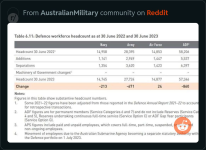Good money after bad, it sounds like, given the continuing (lack of) numbers crisis...
Retention in the Australian Defence Force
Scale of the retention challenge
The Department of Defence’s (Defence)
plan to grow its military and civilian permanent workforce to
over 101,000 by 2040 is an ambitious undertaking.
Defence’s March 2023 submission to the Joint Standing Committee on Foreign Affairs, Defence and Trade (JSCFADT) states that the Australian Defence Force (ADF) is operating at 3,300 below its Average Funded Strength. The current planned
ADF workforce in 2023–24 is 59,673. Additionally, planned recruiting levels and entrants into the permanent ADF are failing to offset outflows, which last year reached around 6,600 separations. The shortfall is greatest across the ADF’s middle ranks. Army reported a
separation rate of 13.2% in 2021–22, with the rates for Navy and Air Force hovering under 10%.
In a more contested and dynamic strategic environment, an effective retention strategy will be as critical as procuring any other capability for the ADF. Workforce challenges are intrinsically linked to the future force the
Defence strategic review (DSR) seeks to deliver. Without the required number of personnel to support high-profile new capabilities, the ADF will struggle to deliver the outcomes the DSR advocates. It is therefore important that Defence creates ‘
a compelling employee value proposition to attract and retain existing personnel’. Restructuring a
defence force that is ‘fit for purpose’ requires investment in recruitment and retention strategies across the maritime, land, air, space and cyber domains. Defence has established a
Tiger Team to drive this work.
Notable retention measures
The evolving strategic landscape underscores the sense of urgency the government brings to this issue, but the
retention of military personnel is not a new challenge. Retention bonuses have often been used by Defence to address specific workforce issues. This includes
bonuses for select reservists, which offer an incentive to help fill gaps in capability.
Retention bonuses were introduced for Army and Navy in 2006 and for specialist categories in
Air Force in 2022, with numerous others created for specialists across the services. In July 2008, Defence credited
retention bonuses as a short-term strategy that helped support a reduction in ADF separations, which, at 9.9%, was at its lowest in almost a decade.
Scale of the retention challenge The Department of Defence’s (Defence) plan to grow its military and civilian permanent workforce to over 101,000 by 2040 is an ambitious undertaking. Defence’s March 2023 submission to the Joint Standing Committee on Foreign Affairs, D

www.aph.gov.au



